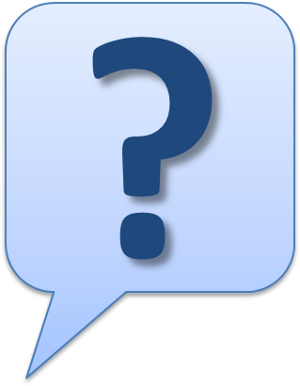| Home » Articles » Speech Writing |
You are certainly aware of this technique, but are you aware that you can use a rhetorical question in at least nine different ways? No? Read on! This article identifies nine ways to use rhetorical questions, and provides examples throughout.
Strategies when asking rhetorical questionsLike other speech techniques, rhetorical questions can be used in a variety of ways, depending on the needs of the speaker and the speech. It is rarely necessary to ask a rhetorical question; there is nearly always another way to convey the same idea without using a question. But rhetorical questions, like other rhetorical devices, add variety and interest to a speech. Here are nine strategies that can be fulfilled (often in combination) with a carefully crafted rhetorical question: 1. Engage the audience to think with a rhetorical question.The most popular use of a rhetorical question is to engage your audience to think. If your entire speech is a series of statements, your audience may passively listen and absorb little. On the other hand, you can make them active participants in your speech by inviting them to think about your arguments. This is most effective if they are asked to think about an issue from a fresh perspective. For example, suppose you are delivering a goal achievement seminar. While many people feel that external forces prevent them from realizing their goals, you might engage your audience to think about their self-defeating behaviors:
2. Invite your audience to agree with you by asking a rhetorical question.To persuade your audience, they must see you as credible. One way to build credibility is to convince your audience that you are similar to them and share their beliefs. One way to do this is by asking a rhetorical question where the answer has the audience agreeing with you, perhaps even nodding their head in agreement. For example, suppose you are speaking at a networking event for working mothers, and you represent a local health spa:
[When your audience silently answers “Yes, I do deserve that”, the effect is that they see themselves as more similar to you.] 3. Stir emotions by asking a rhetorical question.Effective speakers know how to stir audience emotions. Rhetorical questions do this by making the audience a partner in your emotional statements. Instead of delivering one-way emotional statements, you can involve your audience more emotionally by hooking them with a rhetorical question. For example, suppose you are at a political rally. Instead of saying:
Try:
The latter version is stronger, because it triggers an emotional response by having the audience thinking “Nothing! They’ve done nothing!” 4. Emphasize a previous statement with a rhetorical question.Rhetorical questions can be used as an exclamation point on a preceding statement. While the preceding statement may be a factual statement, a rhetorical question forces your audience to think hard about it. For example, suppose you are speaking out against gang violence in your community:
5. Invoke misdirection with a rhetorical question.Careful use of misdirection in a speech is an effective way of generating audience surprise, and this results in them being active participants. One form of misdirection is when you make a statement which leads in one direction, and then follow it up with a statement that pulls in the opposite direction. For example, suppose you are trying to motivate your sales department:
In the above example, the rhetorical question followed a contrasting statement. But this pattern can be reversed with the rhetorical question preceding a contrasting statement. For example:
6. Ask and answer a rhetorical question your audience may be thinking.Thorough audience analysis will reveal many questions that members of your audience may have. Rather than waiting to address these questions following your speech (e.g. in a Q&A session), you can address them in the body of your speech by asking the question and immediately answering it. For example, imagine that you are speaking to a new parents’ support group:
Or, consider another example:
7. Answer a question with another rhetorical question.A common technique to answer a question (either one you have raised, or one coming from your audience) is to respond with a rhetorical question. This is done when the two questions (the one you were asked, and the one you responded with) have the same answer (typically, either “yes” or “no”). For example:
The obvious answer to the second question is “yes”, and this implies the answer to the first is also “yes”. Or, consider another example:
This time, the obvious answer to the second question is “no”, and this implies the answer to the first is also “no”. Beware when using this technique as it can sound cliche to your audience. If you can, make the second question fresh and unique to your audience. 8. Ask a series of rhetorical questions to highlight divergent thoughts.When speaking about a particularly complex issue, one technique that reinforces this complexity is to ask a series of questions which, if answered, would all point in different directions. For example:
A series of questions like this might be used in the opening of a speech, while the body of the speech might follow up on the individual questions one by one. 9. Ask a series of rhetorical questions to highlight convergent thoughts.A series of rhetorical questions can also be used in situations where, if the questions were answered, all of the answers would point in the same direction. This technique is a variation on repetition and could be used to emphasize a point repeatedly. For example:
What do you think?That’s not a rhetorical question. I really do want to hear what you think. Please add a comment to share your ideas about how to use rhetorical questions. | |
| Views: 463 | |
| Total comments: 0 | |
